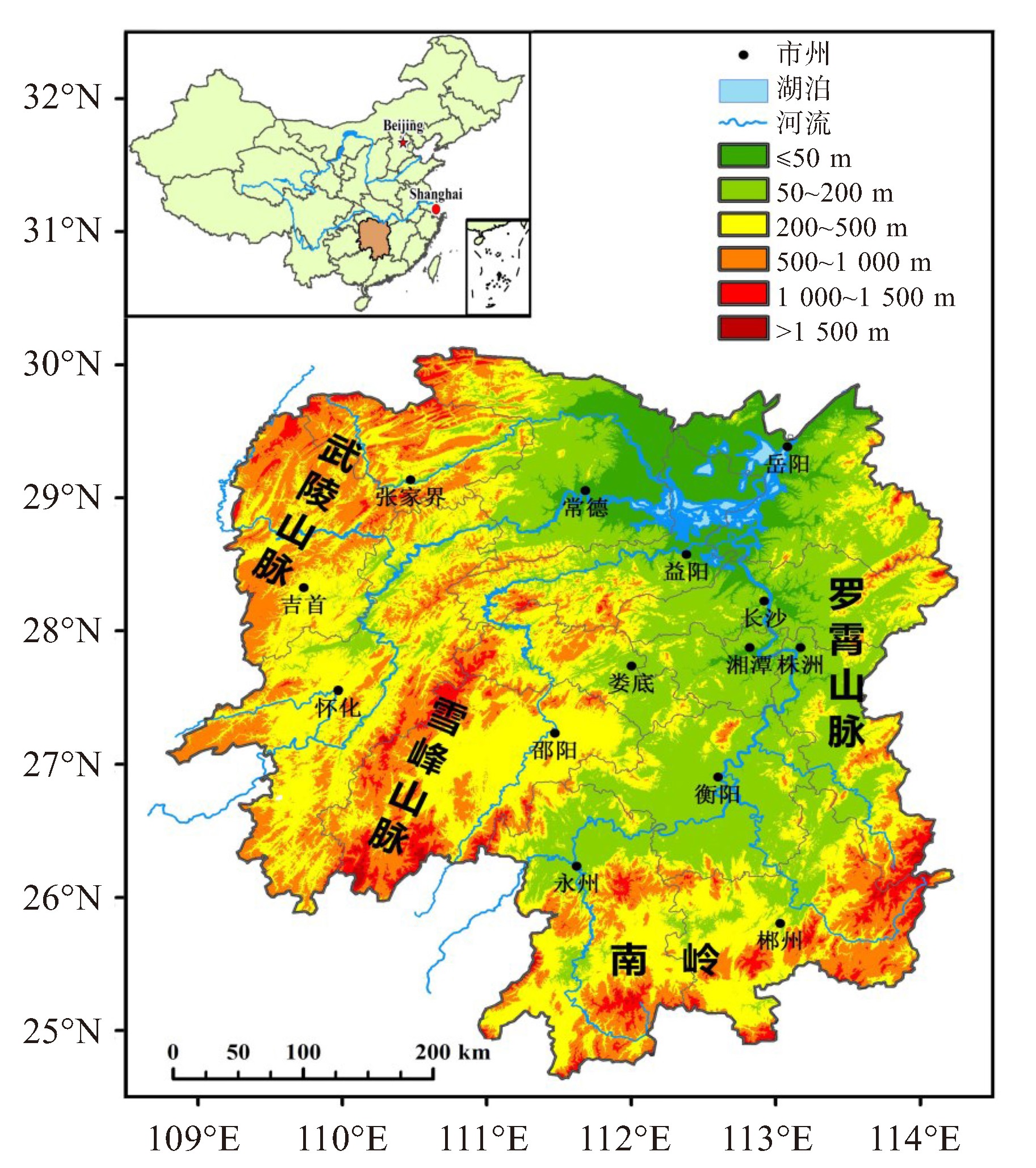Daily Maximum and Minimum Temperature Forecasts Correction Based on Deep Learning Model Ensemble
-
摘要: 采用2018—2023年中国气象局陆面数据同化系统的气温资料以及欧洲中期天气预报中心的高分辨率模式预报产品(ECMWF-IFS),分别建立基于时空堆叠的残差网络(Res-STS)以及基于自注意力(Self-Attention)机制的长短期记忆网络(Attention-LSTM),并将两个模型进行集成,构建集成神经网络模型(Ensemble),得到涵盖湖南地区的0.05 °×0.05 °气温网格日最高、最低气温预报产品。结果表明:深度学习模型均有效改善了ECMWF-IFS预报效果,0—24 h预报时效日最高气温的平均绝误差(MAE)相比ECMWF-IFS和中央气象台指导报(SCMOC)分别降低了25.76%~40.40%和15.03%~31.79%,日最低气温的MAE分别降低了10.53%~31.58%和5.31%~19.47%,其中Ensemble模型在绝大多数月份的预报效果均是最优。同时,Ensemble模型有效弥补了ECMWF-IFS对地形复杂区域预报效果弱的缺陷,日最高气温预报准确率(F2)达85% 的面积占比为17.31%,而其余模型低于6%;日最低气温F2达90%的面积占比为68.63%,高出单一模型21.08%~63.09%。由此可见,多模型集成能够显著提高气温预报的准确性和可靠性。
-
关键词:
- Res-STS /
- Attention-LSTM /
- 多模型集成 /
- ECMWF-IFS /
- 气温预报
Abstract: Using temperature data from the China Meteorological Administration (CMA) Land Data Assimilation System and high-resolution forecast products from the European Centre for Medium-Range Weather Forecasts Integrated Forecasting System (ECMWF-IFS) during 2018—2023, we developed two deep learning frameworks: a residual spatiotemporal stacking network (Res-STS) and a self-attention long short-term memory network (Attention-LSTM). An ensemble model was subsequently developed from these two models to produce 0.05 ° × 0.05 ° gridded temperature forecasts specific to the Hunan region. Validation results for the year of 2023 indicate that the deep learning models effectively improved the accuracy of ECMWF-IFS forecasts. For the 0~24 h forecasts, the mean absolute error (MAE) of daily maximum temperature was reduced by 25.76%~40.40% compared to the ECMWF-IFS products and by 15.03%~31.79% compared to the products from the System of Central Meteorological Observatory for Correction (SCMOC), CMA. The MAE of daily minimum temperature was reduced by 10.53%~31.58% compared to the ECMWF-IFS products and by 5.31%~19.47% compared to products from the SCMOC, with the ensemble model performing the best. Furthermore, the ensemble model effectively mitigated the limitation of the ECMWF-IFS in forecasting within complex terrain. The proportion of areas achieving an F2 score of 85% for daily maximum temperature was 17.31%, mainly in the Dongting Lake plain area, whereas it was below 6% in other models. For daily minimum temperature, the area with an F2 score of 90% reached 68.63%, which was 21.08%~63.09% higher than those of other models. Overall, the ensemble model exhibited superior forecasting performance in most months. The integration of multiple models and deep learning can significantly enhance the reliability and accuracy of temperature forecasts.-
Key words:
- Res-STS /
- Attention-LSTM /
- multimodel ensemble /
- ECMWF-IFS /
- temperature forecast
-
表 1 预报因子选取
气压层 要素 地面 海平面气压、总降水量、10 m经向风*、10 m纬向风*、2 m温度*、2 m露点温度* 1 000 hPa 相对湿度、散度 925 hPa 相对湿度、散度、温度* 850 hPa 纬向风*、温度*、相对湿度 700 hPa 经向风*、温度* 600 hPa 相对湿度 500 hPa 经向风、纬向风、温度*、相对湿度 标注*为通过相关分析筛选的因子。 表 2 不同模型在不同起报时次日最高、最低气温产品的评估指标对比
起报时次 模型 日最高气温 日最低气温 F2/% R MAE/℃ ACC F2/% R MAE/℃ ACC 08 ECMWF-IFS 57.04 0.97 1.98 0.70 78.31 0.98 1.33 0.64 SCMOC 64.36 0.97 1.73 0.79 84.10 0.99 1.13 0.79 Res-STS 73.35 0.98 1.47 0.76 82.22 0.99 1.19 0.77 Attention-LSTM 82.20 0.99 1.20 0.86 90.05 0.99 0.93 0.86 Ensemble 82.33 0.99 1.18 0.86 90.53 0.99 0.92 0.86 20 ECMWF-IFS 54.77 0.96 2.06 0.68 78.12 0.98 1.33 0.65 SCMOC 60.59 0.97 1.84 0.77 84.16 0.98 1.13 0.79 Res-STS 72.12 0.98 1.51 0.76 85.86 0.99 1.07 78 Attention-LSTM 78.57 0.98 1.31 0.84 88.67 0.99 0.98 0.85 Ensemble 80.10 0.98 1.26 0.85 90.93 0.99 0.91 0.86 表 3 本次强降温过程不同模型表现效果评估
类型 模型 不同时间模型表现效果(MAE/℃) 4月21日08时—22日08时
(开始降温)4月22日08时—23日08时
(降温最剧烈)4月24日08时—25日08时
(开始升温)4月21日08时—25日08时
全过程)日最高气温 ECMWF-IFS 1.41 2.46 1.53 1.86 SCMOC 1.23 2.43 1.42 1.86 Res-STS 1.96 1.23 0.85 1.25 Attention-LSTM 1.01 2.23 0.94 1.3 Ensemble 1.28 1.33 0.78 1.06 日最低气温 ECMWF-IFS 1.94 1.32 0.85 1.30 SCMOC 1.82 1.12 0.77 1.15 Res-STS 1.27 1.05 0.88 1.05 Attention-LSTM 1.77 1.15 0.62 1.09 Ensemble 1.41 1.00 0.57 0.96 -
[1] HACKER J P, RIFE D L. A practical approach to sequential estimation of systematic error on near-surface mesoscale grids[J]. Wea Forecasting, 2007, 22(6): 1 257-1 273. [2] World Meteorological Organization. Guide to meteorological instruments and methods of observation[M]. Secretariat of the World Meteorological Organization, 1983. [3] SEKULA P, BOKWA A, BOCHENEK B, et al. Prediction of air temperature in the Polish Western Carpathian Mountains with the ALADINHIRLAM numerical weather prediction system[J]. Atmos, 2019, 10(4): 186. [4] 朱玉祥, 黄嘉佑, 丁一汇. 统计方法在数值模式中应用的若干新进展[J]. 气象, 2016, 42(4): 456-465. [5] LIU J, ZHANG H, LI H, et al. Improving forecast accuracy with an auto machine learning post-correction technique in northern Xinjiang[J]. Appl Sci, 2021, 11(17): 7 931. [6] 李佰平, 智协飞. ECMWF模式地面气温预报的四种误差订正方法的比较研究[J]. 气象, 2012, 38(8): 897-902. [7] 马旭林, 时洋, 和杰, 等. 基于卡尔曼滤波递减平均算法的集合预报综合偏差订正[J]. 气象学报, 2015, 73(5): 952-964. [8] HAN L, CHEN M, CHEN K, et al. A deep learning method for bias correction of ECMWF 24-240 h forecasts[J]. Adv Atmos Sci, 2021, 38 (9): 1 444-1 459. [9] FANG Y, WU Y, WU F, et al. Short-term wind speed forecasting bias correction in the Hangzhou area of China based on a machine learning model[J]. Atmos Oceanic Sci Lett, 2023, 16(4): 100339. [10] 竺夏英, 孙林海, 钟海玲, 等. 2023年中国气候异常特征及主要天气气候事件[J]. 气象, 2024, 50(2): 246-256. [11] 陈鹤, 蔡荣辉, 陈静静, 等. 基于深度学习方法的气温预报技术应用与评估[J]. 气象, 2022, 48(11): 1 373-1 383. [12] 赵琳娜, 卢姝, 齐丹, 等. 基于全连接神经网络方法的日最高气温预报[J]. 应用气象学报, 2022, 33(3): 257-269. [13] 张延彪, 宋林烨, 陈明轩, 等. 基于卷积神经网络的京津冀地区高分辨率格点预报偏差订正试验[J]. 大气科学学报, 2022, 45(6): 850- 862. [14] WANG F, TIAN D, CARROLL M. Customized deep learning for precipitation bias correction and downscaling[J]. Geosci Model Dev, 2023, 16(2): 535-556. [15] BLUNN L P, AMES F, CROAD H L, et al. Machine learning bias correction and downscaling of urban heatwave temperature predictions from kilometre to hectometre scale[J]. Meteor Appl, 2024, 31(3): e2200. [16] 张延彪, 陈明轩, 韩雷, 等. 数值天气预报多要素深度学习融合订正方法[J]. 气象学报, 2022, 80(1): 153-167. [17] CHO D, IM J, JUNG S. A new statistical downscaling approach for short‐term forecasting of summer air temperatures through a fusion of deep learning and spatial interpolation[J]. Quart J Roy Meteor Soc, 2024, 150(760): 1 222-1 242. [18] 胡莹莹, 庞林, 王启光. 基于深度学习的7~15 d温度格点预报偏差订正[J]. 应用气象学报, 2023, 34(4): 426-437. [19] 朱鹏程, 王东海, 曾智琳, 等. 粤港澳大湾区汛期降水的多模式集成预报方法的评估检验[J]. 热带气象报, 2024, 40(2): 258-271. [20] CHO D, YOO C, IM J, et al. Comparative assessment of various machine learning‐based bias correction methods for numerical weather prediction model forecasts of extreme air temperatures in urban areas[J]. Earth Space Sci, 2020, 7(4): e2019EA000740. [21] 谢舜, 孙效功, 张苏平, 等. 基于SVD与机器学习的华南降水预报订正方法[J]. 应用气象学报, 2022, 33(3): 293-304. [22] GANAIE M A, HU M, MALIK A K, et al. Ensemble deep learning: A review[J]. Eng Appl Artif Intel, 2022, 115: 105151. [23] 朱育雷, 杨静, 钟水新, 等. 基于多神经网络的动态权重集成温度预报订正研究[J]. 热带气象学报, 2024, 40(1): 156-168. [24] 陈昱文, 黄小猛, 李熠, 等. 基于ECMWF产品的站点气温预报集成学习误差订正[J]. 应用气象学报, 2020, 31(4): 494-503. [25] AMINI A, DOLATSHAHI M, KERACHIAN R. Adaptive precipitation nowcasting using deep learning and Ensemble modeling[J]. J Hydrol, 2022, 612: 128197. [26] CRAVEN J P, RUDACK D E, SHAFER P E. National Blend of Models: a statistically post-processed multi-model Ensemble[J]. J Oper Meteorol, 2020, 8(1): 1-14. [27] 智协飞, 王田, 季焱. 基于深度学习的中国地面气温的多模式集成预报研究[J]. 大气科学学报, 2020, 43(3): 435-446. [28] 兰明才, 唐杰, 周莉, 等. 基于逐步回归模型的华南区域模式气温预报产品释技术研究[J]. 气象与环境科学, 2023, 46(5): 86-95. [29] ZHOU L, CHEN H, XU L, et al. Deep learning‐ based postprocessing for hourly temperature forecasting[J]. Meteor Appl, 2024, 31(2): e2194. [30] XU L, ZHOU L, CHEN H, et al. A deep learning network for improving predictions of maximum and minimum temperatures over complex terrain[J]. Theor Appl Climatol, 2024: 1-15. [31] ZHANG C J, ZENG J, WANG H Y, et al. Correction model for rainfall forecasts using the LSTM with multiple meteorological factors[J]. Meteor Appl, 2020, 27(1): e1852. [32] 杨璐, 南刚强, 陈明轩, 等. 基于三种机器学习方法的降水相态高分辨率格点预报模型的构建及对比分析[J]. 气象学报, 2021, 79(6): 1 022-1 034. [33] 翁少佳, 蔡锦海, 庞运禧, 等. 卷积神经网络在近岸表层海温预报中的应用[J]. 热带海洋学报, 2024, 43(1): 40-47. [34] VASWANI A, SHAZEER N, PARMAR N, et al. Attention Is All You Need[J]. arXiv, 2017. [35] 潘留杰, 薛春芳, 王建鹏, 等. 一个简单的格点温度预报订正方法[J]. 气象, 2017, 43(12): 1 584-1 593. [36] 蔡康龙, 胡志群, 谭浩波, 等. 利用卷积神经网络开展偏振雷达定量降水估测研究[J]. 热带气象学报, 2024, 40(1): 64-74. [37] 黄天文, 焦飞, 伍志方. 一种基于迁移学习和长短期记忆神经网络的降水预报方法[J]. 暴雨灾害, 2024, 43(1): 45-53. -






 下载:
下载:








 粤公网安备 4401069904700003号
粤公网安备 4401069904700003号